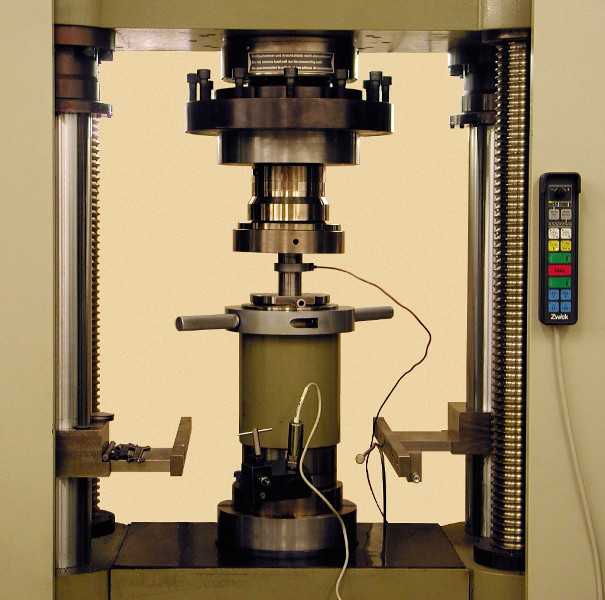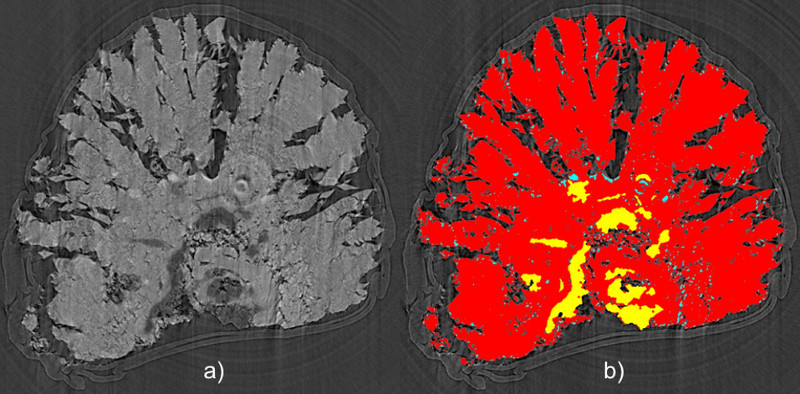Department of laboratory research on geomaterials
| Doc. Ing. Jiri Scucka, Ph.D. | ||
| Bc. Lucie Hronova Dr. Vishnu Chitralekha Satheesan Doc. Ing. Ivan Janecek, CSc. Ing. Alena Kozusnikova, CSc. Ing. Lucie Kralova Milan Kraus | Alena Krocova Miroslava Krupikova Ing. Katerina Mareckova Prof. Ing. Petr Martinec, CSc. Renata Papcunova Ing. Eva Plevova, Ph.D. | Mgr. Lucie Ruppenthalova, Ph.D. Ing. Lenka Vaculikova, Ph.D. Ing. Vera Valovicova, Ph.D. Prof. Ing. Zdenek Vasicek, DrSc. Ing. Leona Vavro, Ph.D. |
The department conducts a comprehensive material research on a wide range of geomaterials and selected construction materials. Mineralogy and petrography belong to the main research areas, where new methodologies of the identification and characterization of materials are being developed especially based on infrared spectroscopy, thermal analysis, optical and infrared microscopy and image processing and analysis. Other important research fields include: mechanical properties of geomaterials in different states of stress; interaction of materials with fluids; and thermal properties of geomaterials. The geology and biostratigraphy of coal basins and geological problems associated with important geotechnical constructions also form a part of the research.
Main research topics
Mineralogy and petrography. We provide petrographic and mineralogical analyses of a wide spectrum of both natural and industrial materials for our partners in industry, science, and education. As far as natural rocks are concerned, we deal primarily with the classification of rocks in petrographic systems and with the analysis of rock composition and structure (particle size distribution, grain sorting, roundness and angularity of clastic grains, the identification of carbonates and clay matrix in rock, coal mass in sediments, transformation of rock-forming minerals, normative composition on the basis of chemical analysis).
As regards industrial materials (such as mineral abrasives, micronized particles, silicate construction materials, and metallurgical by-products), we determine the structure, composition, grain and pore size distribution, and the type and intensity of corrosion and alteration.
Coal petrology includes maceral analysis of coal, determining mineralization in coal, analysis of the coal micro-fracturing before and after deformation tests; micro-hardness measurements, and textural analysis of metallurgical cokes.
Image processing and analysis of geomaterials and construction materials. For the study of the composition and structural-textural parameters of geomaterials and construction materials, methods of digital image processing and analysis are used and developed in the department. The procedures of image analysis are used mainly for quantification of the composition and structural parameters of materials; the analysis of shape, size and orientation of particles; the analysis of the size and distribution of pores; the measurement of intensity and orientation of micro-fracturing, etc. Department personnel have developed many new algorithms and methodologies which have been applied in morphological analyses of geomaterials at different scale levels. For example, the methodology for determining changes in micro-fracturing distribution in rocks during the mechanical loading has been developed (microscopic scale). The methodology of the evaluation of grain morphology of aggregates for construction purposes has been prepared and verified (mesoscopic scale), which enables the description and quantification of the morphometric parameters of aggregate grains in relation to the anisotropy and micro-fracturing in primary rocks and their use in modelling in civil engineering and geotechnics. Furthermore, the methodology for the quantification of structural-textural parameters of underground working faces has been developed as part of a geotechnical survey in the underground engineering (macroscopic scale). This makes possible a significant improvement in the knowledge from the investigation of a working face, while simultaneously eliminating safety risks.


Research on physical properties of geomaterials. The other area of research is the study of effects of thermo-hydro-mechanical processes on physical properties of geomaterials, such as mass and volume density; capillary absorptive capacity; water absorption; ultrasonic wave velocity; thermal conductivity; specific thermal capacity; and thermal expansion. The strength and strain properties are measured in laboratory tests of compression strength and tensile strength, where the Young modulus and Poisson’s ratio under the uniaxial and triaxial state of stress and the ultrasonic wave velocity in the deformation process are determined. The results of triaxial tests are further utilized in the construction of Mohr’s criteria.
Particular attention is paid to the study of the permeability of rocks and coal in the triaxial state of stress. The measuring equipment consists of a triaxial cell KTK 100, modified for gas passage. The confining pressure is applied by the pressure of hydraulic oil up to a maximum value of 100 MPa. The computer controlled mechanical press ZWICK 1494, with a maximum force of 600 kN, is the source of axial stress. Usually, nitrogen is used as a gas medium for the permeability measurements. The effect of various parameters (structure; anisotropy and composition; the increase in hydro-static pressure; the increase in axial stress and temperature) on the permeability of rock and coal under the triaxial state of stress is studied.
Extensive series of sedimentary carboniferous rocks and coals have already been tested by the methodology for the measurement of permeability developed by the department personnel. In recent years, research has been focused on granitic rocks from important localities in the Czech Republic. Within the RDIOP project Institute of Clean Technologies for Mining and Utilization of Raw Materials for Energy Use, the department obtained new sophisticated hydraulic equipment, MTS, for the mechanical testing of rocks. This equipment enables to conduct a wide spectrum of tests of mechanical properties, including, for example, determining the fracture toughness of rocks or measuring the permeability of rocks for liquids.
Research on clay minerals. The issue of clay minerals has been studied by our department for many years. In close cooperation with the VSB – Technical University of Ostrava and the University of Ostrava, research into nano-materials based on clay minerals is performed; together with the study of the thermal stability of composite materials; and the development of applications of the FTIR and Raman spectroscopy for the identification and quantification of clay minerals. The reason for the continuing interest in clay minerals is their remarkable capability to absorb organic or inorganic compounds into their crystal structure. Besides their traditional role as sorbents, clay minerals represent a means in the development of new materials with predefined properties - nano-composites. The knowledge about the properties of nano-composites contributes to the solution of current problems associated with the preparation of sorbents for the removal of substances from various environmental burdens, with the formation of barriers for depositing waste, or the reinforcement and stabilization of soils with a high content of clays and humic substances.
The application of thermal analysis is also being developed in the department with the study of sorption and mechanical properties of clay minerals and modified clays. Within the study of thermal stability of geomaterials, a comprehensive database of thermal curves of clay minerals, their admixtures and selected types of sedimentary rocks has been prepared. For the most part, the changes of weight dependent on temperature and time in various atmospheres (oxidation, inert atmosphere, high vacuum) are evaluated. The temperature of dehydration, dehydroxylation and transformations of individual minerals and kinetic parameters of running reactions are also determined. Thanks to advanced kinetic software, we can also predict the process of reaction and thermal stability of material in an optional temperature mode.
A further trend in research is the application of FTIR and Raman spectroscopy to the qualitative and quantitative analysis of clay minerals in rocks, primarily in those areas where the presence of clay minerals significantly affects the physical and chemical properties of rocks – in geomechanics, when ensuring the slope stability, in the solution of problems regarding the construction and stability of underground construction and in many other fields when the Earth’s crust is to be affected. In recent years, attention has been focused on the utilization of statistical multivariation methods in the analysis of infrared spectra of minerals and rocks.
Research on concrements of urinary tract. For many years, our department has also been dealing with the mineralogical analyses of concrements of the urinary tract of patients from the Ostrava region. The data of more than 16000 patients have been investigated to date. Not only are mineralogical analyses utilized, but also the analyses of trace elements content and the micro-CT tomography of the concrement samples. This research shows the complexity of the inner structure of concrements originating in the dynamic environment of the human body and specificities of mineral structures developed in the organic environment. It was found out that urinary calculi of patients from the Ostrava agglomeration contain 130 mineral combinations, while the Ca–oxalate and Ca,Mg-phosphate concrements are completely dominant. The aim of the research is to find out the development of mineral occurrence of urinary tract stones in patients from the Ostrava region in the years 1978 – 2011, in relation to sex, age, and location of stones. Furthermore, the aim is to find the relationships between the character of urinary calculi and significant socioeconomic changes in the Czech Republic. The research is conducted in cooperation with the Department of clinical biochemistry of the Municipal Hospital in Ostrava, with Hospital Frydek-Mistek, Brno University of Technology, Masaryk University Brno, Sincrotrone Trieste S.C.p.A., Italy, and Calculi - Laboratory Specializing in Urinary Stones Analyses, Brno.
Structure and properties of geocomposite materials. Over a considerable period, the department has dealt with unique research into the structure and properties of geocomposites – specific materials created by pressure grouting of chemical grouts into soils, disturbed rocks or into damaged building constructions. The research is carried out in collaboration with the Department of geomechanics and mining research and primarily includes the development and application of methodologies for the visualization of the geocomposite structure; the quantification of structural-textural parameters; the study of relationships between the material structure and its physical-mechanical properties and the evaluation of thermal stability of chemical grouts in geotechnical or building constructions. Special attention is paid to important anomalies in the structure of geocomposite monoliths created during the particular geotechnical applications and to their effect on the behaviour of material in the construction.
Geology of coal basins. For many years the department has been dealing with problems associated with the geology of coal basins. For the most part, this research topic includes the geological documentation of boreholes and mine workings; sedimentological and lithological analysis of rocks and coal. Considerable attention is focused on the research and identification of correlation horizons in coal basins, the results of which are continuously used, primarily in the correlation of coal seams in the Czech part of the Upper Silesian Coal Basin. From both a social and economic aspect, another important area of research, in which department personnel have been involved for many years, is the study of the bonding of gases in coal mass and in rocks in connection with the technology of coal bed methane extraction; with the CO2 storage and with the occurrence of gas-dynamic phenomena jeopardizing the safety of work underground. In 2012, the results of this work were published in the monograph Carbon dioxide and rock massif ( PDF, 7 MB ).
Other information
|
Recently solved projects ( PDF, 207 kB )
Selected publications ( PDF, 248 kB ) |
Technical equipment ( PDF, 527 kB ) |













